CC/OPC: ToP v. Defense
Coaching Change / Offensive Philosophy Change: Time of Possession v. Defense
I originally wasn’t going to post this because I thought it was just a question in my own head, and I didn’t find a signficant result. However, given the top item in Brian’s mailbag today, and since I had already done the quick analysis, I thought it would be worthwhile to share.
The question had to do with whether Michigan’s struggles on defense were related to the fact that its offensive philosophy often results in short possessions, exposing the defense to being on the field for a longer period of time. So I decided to see if there was a correlation between a team’s offensive Time of Possession and its defense.
Using Time of Possession data from teamrankings.com and Defensive FEI data from footballoutsiders.com:

R-squared is 0.03 - not significant.
“Ok,” I thought, “maybe the way that DFEI is calculated already takes Time of Possession into account. What if we looked at Time of Possession versus Total Defense (yards)? Surely there would be a correlation, especially since defenses that force short possessions by the opponent (3-and-outs, turnovers, etc.) would result in more possessions by their team’s offense, and more Time of Possession.”
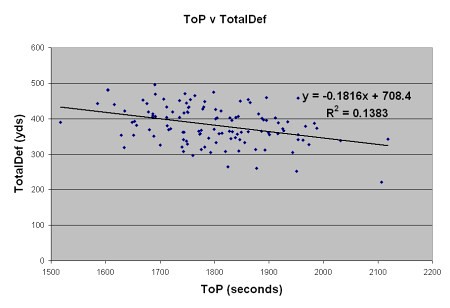
R-squared is 0.14 - still not really significant.
“Fine,” I said, “maybe I should look at Time of Possession versus Scoring Defense - because that’s what really counts. An offense that can control the ball can help protect its defense, and keep the score down."
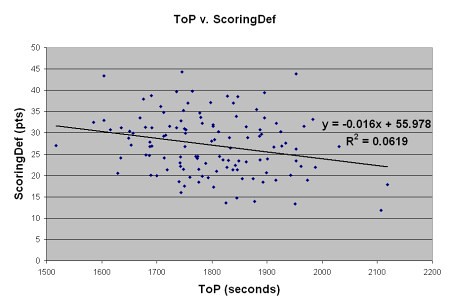
R-squared is 0.06 - not significant.
Finally, I reached back into one of the motivations for looking at this question to begin with. Why would anyone talk about Time of Possession on offense as if it were an important factor on defense, especially with respect to Michigan? Could it be because Stanford leads the country in Time of Possession, and one might try to argue that a CC that shifts the offensive philosophy towards a more ball-control, time-of-possession system would be a good way to help Michigan’s defense?
So what if we looked at the Change in Time of Possession from last year to this year, and compared it to the Change in Total Defense (least insignificant result from above)?
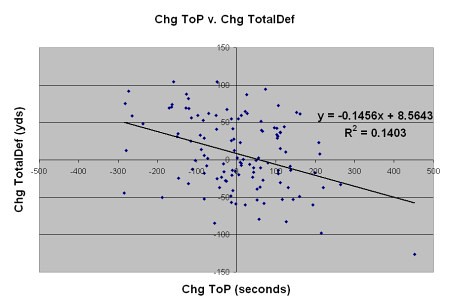
R-squared is 0.14 - still not really significant.
What this says to me is that there are too many variables that influence how a defense performs; one cannot boil it down to a simple thing like Time of Possession (or experience on a depth chart, for that matter). All of those factors may play a part, but no one individual factor is significantly correlated to a team’s performance on defense. Football is just too complex to boil down into simplistic truisms.
***** ADDENDUM *****
A related question has been raised - whether there is a link between the number of possessions and the performance of the defense. I used cfbstats.com to add up the number of 4th down conversion attempts, punts, passing TDs, rushing TDs, FG attempts, Interceptions thrown, and Fumbles lost to calculate the total number of offensive possessions (this may exclude offensive possessions at the end of each half where time simply runs out, and does not differentiate between an offense trying to score v. trying to run out the clock).
Looking at Offensive Possessions versus Defensive FEI:
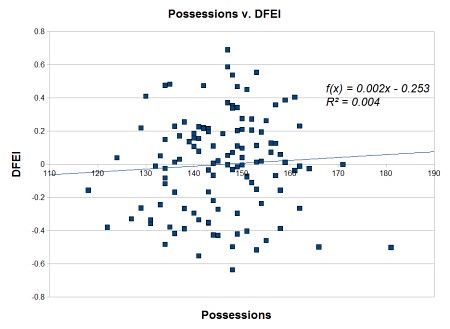
R-squared is 0.004 - not significant.
What about Offensive Possessions versus Total Defense?
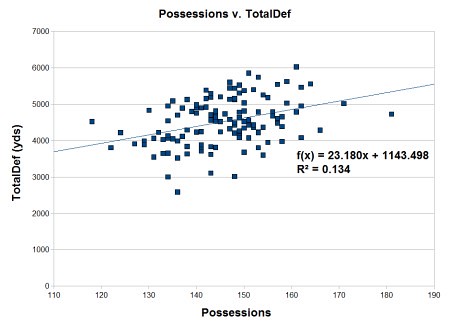
R-squared is 0.13 - still not really significant.
Finally, what about Offensive Possessions versus Scoring Defense?
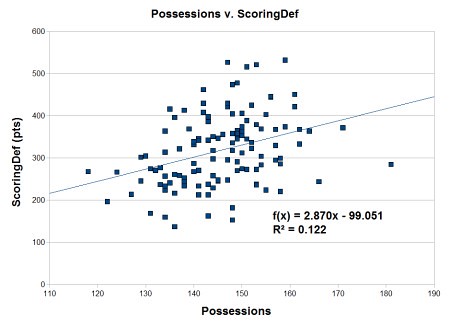
R-squared is 0.12 - again, still not really significant.
Obviously, if the underlying parameters of a model do not show correlation, one should not expect a calculated value based on those parameters to show a correlation. Nevertheless, for the sake of completion, here is the Average Time per Possession versus Total Defense:
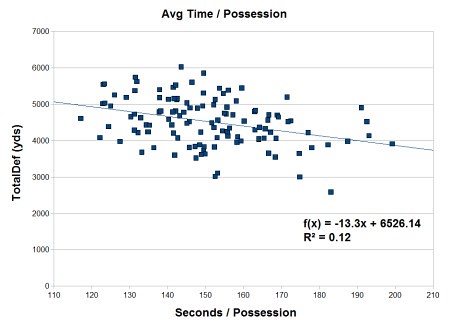
R-squared, as expected, is still only 0.12 - not really significant.
I'm afraid even looking at number of possessions rather than simply time of possession doesn't change the analysis. This suggests to me that the style of offense does not have a significant impact on the performance of the defense.
December 17th, 2010 at 4:55 PM ^
December 17th, 2010 at 4:57 PM ^
that's kind of what brian said - it may be a factor, but not a big one.
good analysis. the bottom line w/ the defense is that if they stopped giving up so many yards, they'd get a rest too.
December 17th, 2010 at 5:04 PM ^
December 17th, 2010 at 7:28 PM ^
The primary reason for our poor defense is lack of talent. RR wanted speed and got it. Unfortunately, speed usually is accompanied by lack of size and strength. Both lead to injuries AND being mauled by bigger but marginally slower players.
December 17th, 2010 at 9:01 PM ^
is a lack of insight. Brian wanted this site to grow in popularity and got it. Unfortunately, quantity usually is accompanied by lack of quality and intelligence. Both lead to readers palm-slamming their foreheads AND your point total being mauled by wiser veteran MGoBlog readers.
December 18th, 2010 at 11:20 AM ^
Personally, I believe there is a high variance in the comparison of quantity and quality. ;-)
December 18th, 2010 at 11:56 AM ^
all I need to do is act as a shill for the Michigan athletic department. Post lavish praise on all the department moves and compliment the players regardless of their performance.
When I read in the Wall Street Journal (thursday Dec.16th) how our once storied program is in the toilet (and it is) then I need to speak out.
I will not join the kiss ass choir if I feel it is not earned or deserved. The negative points I have represent my badge of honor. So keep giving me negative points. I could not be happier.
December 19th, 2010 at 6:22 PM ^
You may prefer to recognize your negative total as a badge of honor. Others will recognize it for what it is..... the result of saying something absolutely ridiculous.
The lack of talent argument is real but it had to do with having to play walk ons and true freshmen and not the type of player RR recruits.
December 20th, 2010 at 3:37 PM ^
is the notion that defensive freshmen are not able to play at a competent level. Several major colleges have freshmen in their lineup. That is RR excuse for poor recruiting and coaching. If a walk on makes the team what does that say about recruiting?
At least you acknowledge that the defense suffers from a lack of talent. You think it may be related to recruiting?:)
December 17th, 2010 at 11:43 PM ^
I agreed with Brian's analysis, but it's nice to see a visual representation of the data to really hammer home the "too many variables" point.
December 18th, 2010 at 1:56 AM ^
My Korean wife (zero knowledge of American sports [I thought]) once asked me "What is this MGoBlog and why is it so interesting?" I said "It's a bunch of nerds trying to understand football with math." I swear to god the next words out of her mouth were "Why don't they write about baseball?"
December 18th, 2010 at 6:00 AM ^
It's not about time of possession so much as the number of defensive drives, the number of defensive plays, and the rest time in between those defensive drives. If the opposing offense has 16 drives, they're going to generally score more points than if they only had 8 drives.
Still, if you were to take our defense from this year and pair it with more of a Wisconsin offense, we would not have had a good defense by any stretch of the imagination. Maybe the 70th or 80th best defense as opposed to the 100 something (obviously depends on which defensive measure you're talking about).
December 18th, 2010 at 10:58 AM ^
I tried to address your question in an addendum above by looking at offensive possessions v. defensive performance. One can assume that the number of offensive possessions is strongly correlated (almost 1-to-1) with the number of defensive possessions, excepting drives at the end of halves or successful onside kicks.
In terms of "rest time" - I looked at the average time per offensive possession, a measure of how long the defense has to "rest" while the offense is on the field. Again, not really a significant correlation between that "rest time" and the defense's overall performance.
December 18th, 2010 at 10:34 PM ^
Perhaps the key relationship between offense and defense and the impact of the offense on the defense has more to do with field position rather than time of posession.
An offense that does not move the ball or turns it over often in negative field position might be the key correlated statistic instead of time of posession.
That might be something you can compare and check the R2 on that might work out. I have a book titled Inside Pro Football that has a number of studies related to pro football that determined this was the key impact that the offense had on the defense for the same team.
December 19th, 2010 at 12:05 AM ^
Sure - it makes sense that where the offense turns over the ball can impact the defense. However, that really has nothing to do with the style of offense, whether "spread" or "pro" or whatever. All offenses are designed to gain yards - the question that seemed to be coming up on the board was whether a particular style of offense was better for the defense.
December 19th, 2010 at 1:33 AM ^
My point for you is that if we are looking to determine whether or how a particular style of offense impacts the defense, and we have a whole ton of data that has just been regressed that says time of posession by the offense is not a big indicator of whether an offense "helps" a defense, we might hypothesize and test to see if the key is not how long they hold the ball, but rather what they do with it during the time of posession and thus where does the opposing team start their next drive.
The book I refer to theorizes and provides a cogent argument with data that the key is field position and the expected outcome of that field position in terms of who will most likely be the next team to score and how many points can they reasonably expect to score. If your offense posesses the ball for 5 minutes but does that by only gaining 30 yards, that is not as effective for your defense as them posessing the ball for 3 minutes but gaining 50 yards.....As an example.....
December 19th, 2010 at 10:01 AM ^
I agree that the field position is more important than time of possession, but I'm still not sure how that is dependent on the "style" of offense. I would expect that both a "spread" and a "pro" offense would be as likely to gain yards, the primary difference being how long it takes for either offense to gain those yards.
December 19th, 2010 at 12:02 AM ^
ToP is one of the most wildly overrated and over-reported statistics in football - it drives me nuts when I hear broadcasters harp on it. Return a kick or interception for a touchdown and your ToP stat will go in the tank. Also, nothing is more demoralizing to a team than having its offense sustain two long drives that end in field goals, and then watch the other team score a quick TD to take the lead.
As to our offense it isn't all about running the plays fast. The idea is to line up fast so the defense has no time to substitute. Once you are lined up you can use as much of the clock as you want - I have heard RR say that one thing he wanted to see was for the offense to in fact use more clock while in formation.
December 19th, 2010 at 7:51 PM ^
R-squared is simply a representation of how much variation is explained by the model. In this case it says that a single factor linear regression is a bad model to use. Whether or not that factor is significant requires a different analysis.
If you want to know if there is a useful trend in these numbers you should use binned averages then plot those. It looks like there might be some useful trends hidden in some of that data.
December 20th, 2010 at 3:32 PM ^
Fair enough - these R values only mean that the two sets of data are not related in a linear way. It does not automatically imply independence.
I'm really not a statistician (one class in undergrad), nor am I really trying to "find useful trends." I'm just trying to answer the general perception of whether "more offensive time of possession = better defense" or "more offensive possessions = worse defense." Given that question, I guess a good alternative analysis would be a rank correlation (ie Spearman). For Time of Possession v. DFEI, Spearman's rho is -0.156 (p = 0.089). For Number of Possessions v. DFEI, rho = 0.076 (p = 0.41). (source with handy Excel spreadsheet)
If I understand my statistics correctly, those rho values near zero, unlike the Pearson linear regression coefficient, do imply that there is NOT a strong correlation.
P.S. Wouldn't comparing bin averages mask a lot of the variance in the underlying data?
December 21st, 2010 at 12:07 AM ^
The short answer to your question (mask variation?) is yes and that's exactly the point.Since you know that there are other factors that influence the results, taking a binned average will help isolate the effect (if any) of the variable you're studying more crisply. Setting variation aside for a moment is a useful thing to do sometimes because it helps you focus on the central tendency of the so-called bin rather than on everything all at once. Once you do that the trend you're looking for is often staring you right in the face. As long as you don't forget that high variation is a relevant piece of information, you're fine. Consider them separately, but consider them both.
An example of how lumping is useful can be shown in the turnover mean regression discussion in this diary. Lumping the data in that case helped demonstrate just how strong the slope actually was even though there was a lot of real variation that needed to be dealt with. You still consider all of the data but you don't get distracted by the variation that is caused by some unknown explanation. The slope is what you're looking for, the flatter it is the weaker the trend.
If you still want to represent the variation you can do it with a confidence interval for the average or some representation of standard error or something. Doing that will give you a clean chart with all the essentials rather than a shotgun blast of data that might lead you to some very unnecessary conclusions.
December 21st, 2010 at 7:11 AM ^
Thank you for the explanation of how looking at binned averages can be helpful. I've grouped the teams into Time of Possession bins based on 10% intervals (top 10%, 2nd 10%, etc.) and calculated the DFEI Avg and StDev of each group in the chart below. The trend is very weak, and the variation is very strong.
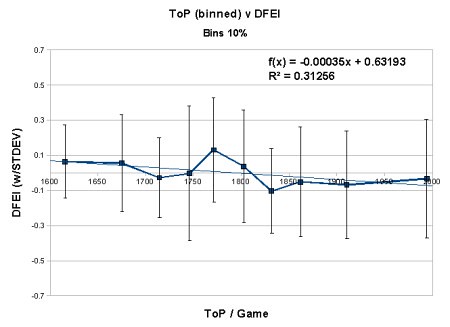
Since the numerical values of DFEI are very small, I decided to look at Total Defense (yards) as well. I also rescaled the Time of Possession into minutes.
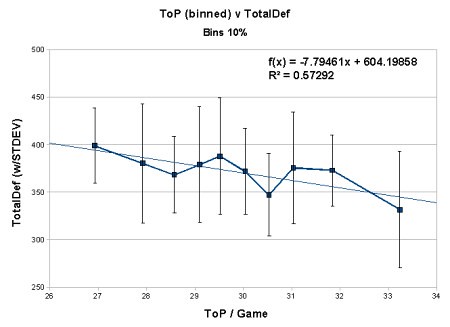
While this does seem to show a slightly stronger trend, it's still pretty weak and the variation is still pretty high. I think this suggests that increasing your Time of Possession by 1 minute will improve your Total Defense by a measly 8 yards. However, one defense could be +/- 50 yards or so compared to another defense in the same 10th percentile of Time of Possession. For example, Michigan is in the bottom 10% of teams in Time of Possession, but the Total Defense of those teams ranges from a Buffalo at 340 yds/game to LA Tech at 462 yds/game (UofM = 448 yds/game).
Taking this analysis to its ridiculous conclusion, UofM would be better off keeping its low Time of Possession offense and trying to emulate Buffalo's defense than trying to improve its Time of Possession to a top 10 percentile rank (Total Defense average 331 yds/game).
December 21st, 2010 at 1:05 PM ^
First, GREAT work, nice graphs, and I know a lot of effort went into compiling the data. Way to advance the discussion!
Echoing MCalibur, I don't think looking just at R2 is the way to go. Binned averages help, but I also just look at the slope of the lines (provided R2 isn't 'meaningless', meaning in my mind below a 0.05 or so). SmithersJoe, do you have the confidence intervals around your coefficients? I'm not sure if we should 'care' about Total Defense (vs. DFEI), but your original plot, your delta plot, and your binned plot all show (to me) a pretty robust relationship between ToP and Total Defense.
I'd be curious what happens if you use both ToP and Total Offense to predict Total Defense. Does Total Offense have any effect? Does more yards gained on offense lead to more yards gained on defense, independent of ToP? There might be a way to tease out the offensive team that goes 3-and-out vs. the offensive team that goes 3-and-score.
Or, is there any relationship at all between ToP and the gap between OFEI and DFEI? Does a team that hogs the ball tend to have a defense that performs more closely to its offense vs. a team that barely has the ball at all? I'll admit I'm not sure what it means if you found something, but it'd be interesting to check...
Comments